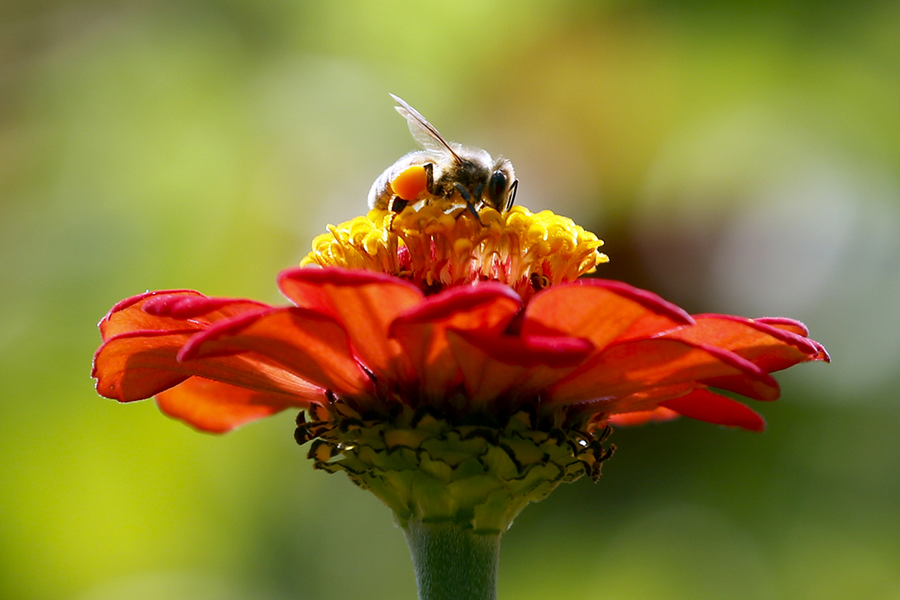Buzzworthy: How you can help America's pollinators
Loading...
How important are bees?
Vital.
Nearly 90 percent of flowering plants and 75 percent of major agricultural crops depend on animal pollination, mostly by bees – and without pollination, plants can't reproduce.
We're not just talking about roses and daisies, either. More than a dozen major food crops couldn't grow without bee pollination, including almonds, apples, cucumbers, and raspberries. Root crops like carrots and onions can self-pollinate, but they won't produce seeds for future plantings without bees.
"Humans will not starve if pollinators disappear, but we will only be eating wind-pollinated grains," explains Michele Colopy of the Pollinator Stewardship Council, an advocacy group based in Akron, Ohio. "Fruits, nuts, and seeds will be rare."
In 2016, US farmers paid $350 million to beekeepers for pollination services, and economists estimate that wild bees contribute billions more in agricultural value to California alone.
Are bees really 'in crisis'?
It's complicated.
Climate change poses a unique threat to wild bees, as many evolved in partnership with just one species of plant or flower. If a warming climate encourages a flower to bloom before its pollinator rouses from winter dormancy, that timing mismatch could be fatal to both species.
As for domesticated honeybees, the number of commercial honeybee colonies has plummeted from a high of 5.9 million in 1947 down to a low of 2.3 million in 2008. They have since rebounded to about 2.8 million colonies.
(For decades, this census ignored "backyard beekeepers" with five or fewer colonies, but those have been counted since 2015. There were 24,000 of these colonies in 2016, which suggests that excluding them from the official census in past years didn't change the results much.)
The number of commercial hives has held fairly steady since 1996, but the annual die-off rate – which used to be about 10 to 15 percent of colonies every winter – is now closer to 20 to 40 percent. The losses have been largely offset by beekeepers splitting their groups of drones and buying new queens.
Most studies focus on commercial honeybees, which are threatened by poor nutrition, diseases, pesticides, and "migratory stress" from being trucked around the country to pollinate crops from California to Maine. For years, scientists worked to identify one key factor, but the growing consensus is that all of these stressors compound each other.
Much less is known about the threats to the 4,000 or so species of wild bees native to North America. (Honeybees, Apis mellifera, are an introduced species from the Old World.) Like most wild animals, bees are threatened by habitat loss from agriculture and urban sprawl, but as wild bee populations have only begun to be counted, it's nearly impossible to know if their numbers are increasing or decreasing.
As threats, "loss of habitat and poor nutrition are probably most critical for wild bees, and Varroa parasites [a type of mite] are most important for honeybees," says Christina Grozinger, distinguished professor of entomology at Pennsylvania State University and the director of the Center for Pollinator Research.
High-quality nutrition – which, for a honeybee, means access to many species of flowering plants, and not the sugar solution often fed to commercial bees – can help bees resist these stressors, she adds.
Is 'colony collapse' still a concern?
Not really.
Colony collapse disorder (CCD) refers to honeybee colonies that meet very specific criteria, including very few worker bees, one live queen, and plenty of food for the baby bees still growing in the hive walls. "Together, these traits suggest that the adult bee population was rapidly eliminated and did not dwindle over a long period of time," says Dr. Grozinger.
CCD burst into public attention after the winter of 2006-2007, when some longtime beekeepers discovered losses of 50 or even 90 percent of their hives. While winter losses still remain higher than past decades, the number of those losses attributed to CCD has dropped from roughly 60 percent of total hives lost in 2008 to very few in recent years.
What is being done now to protect bees?
On June 20, 2014, then-President Barack Obama called on federal agencies to increase and coordinate their efforts to improve bee health by developing an integrated strategy. One effect of that was the expansion and protection of pollinator habitat across the country.
In addition, the Environmental Protection Agency began working with states, tribes, and private stakeholders to create "Managed Pollinator Protection Plans" (MP3s), statewide agreements to meet the local needs of agriculture, beekeepers, and the bees themselves.
These plans include best practices like limiting pesticide applications to times when bees are less active (like after nightfall) and warning beekeepers before administering pesticides.
In January, the EPA announced new rules to limit the use of "neonicotinoid pesticides," sometimes called neonics, which have been shown to weaken bees' immune systems.
How can I help?
Avoid spraying pesticides on blooming flowers – wait until after the petals have fallen, when the plants are less attractive to bees. If you must apply pesticides to blooms, spray at night and seek out a product with a "short residual toxicity." Read labels, and avoid pesticides that contain neonics like clothianidin, dinotefuran, imidacloprid, or thiamethoxam. If you buy plants from a nursery, make sure the plants haven't been treated with neonics, as the leaves and flowers can remain toxic long after application.








